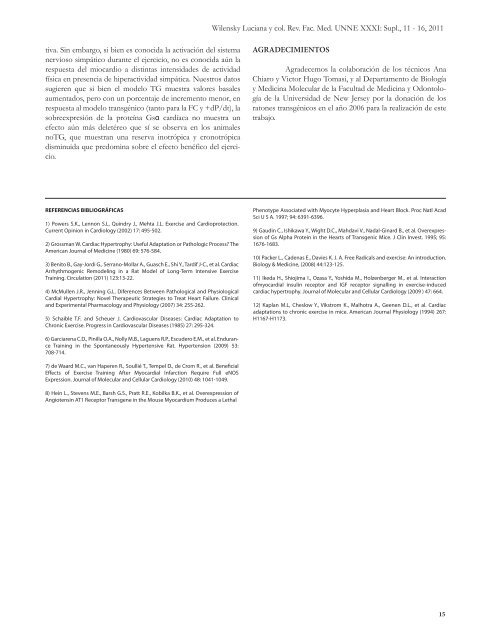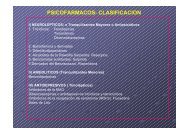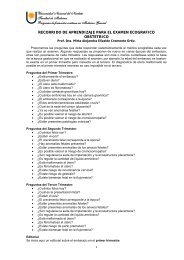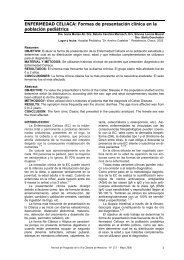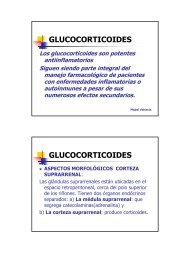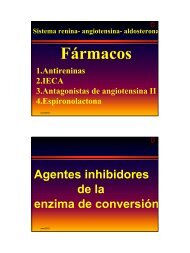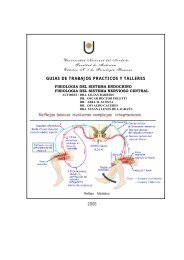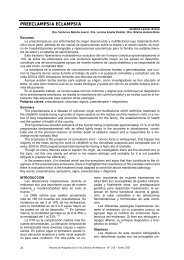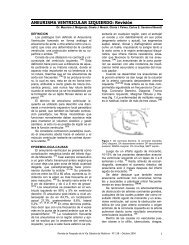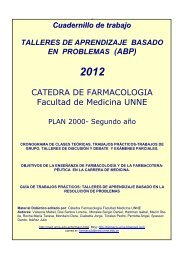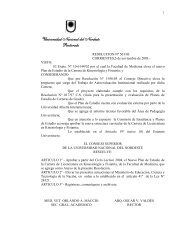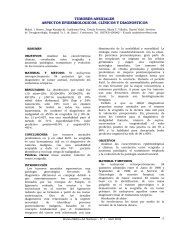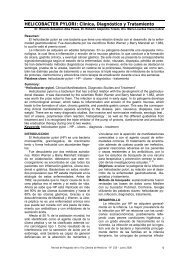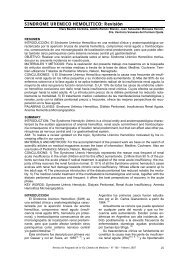Suplemento 2011 - Facultad de Medicina - Universidad Nacional ...
Suplemento 2011 - Facultad de Medicina - Universidad Nacional ...
Suplemento 2011 - Facultad de Medicina - Universidad Nacional ...
You also want an ePaper? Increase the reach of your titles
YUMPU automatically turns print PDFs into web optimized ePapers that Google loves.
Wilensky Luciana y col. Rev. Fac. Med. UNNE XXXI: Supl., 11 - 16, <strong>2011</strong><br />
tiva. Sin embargo, si bien es conocida la activación <strong>de</strong>l sistema<br />
nervioso simpático durante el ejercicio, no es conocida aún la<br />
respuesta <strong>de</strong>l miocardio a distintas intensida<strong>de</strong>s <strong>de</strong> actividad<br />
física en presencia <strong>de</strong> hiperactividad simpática. Nuestros datos<br />
sugieren que si bien el mo<strong>de</strong>lo TG muestra valores basales<br />
aumentados, pero con un porcentaje <strong>de</strong> incremento menor, en<br />
respuesta al mo<strong>de</strong>lo transgénico (tanto para la FC y +dP/dt), la<br />
sobreexpresión <strong>de</strong> la proteína Gsα cardíaca no muestra un<br />
efecto aún más <strong>de</strong>letéreo que sí se observa en los animales<br />
noTG, que muestran una reserva inotrópica y cronotrópica<br />
disminuida que predomina sobre el efecto benéfico <strong>de</strong>l ejercicio.<br />
AGRADECIMIENTOS<br />
Agra<strong>de</strong>cemos la colaboración <strong>de</strong> los técnicos Ana<br />
Chiaro y Victor Hugo Tomasi, y al Departamento <strong>de</strong> Biología<br />
y <strong>Medicina</strong> Molecular <strong>de</strong> la <strong>Facultad</strong> <strong>de</strong> <strong>Medicina</strong> y Odontología<br />
<strong>de</strong> la <strong>Universidad</strong> <strong>de</strong> New Jersey por la donación <strong>de</strong> los<br />
ratones transgénicos en el año 2006 para la realización <strong>de</strong> este<br />
trabajo.<br />
REFERENCIAS BIBLIOGRÁFICAS<br />
1) Powers S.K., Lennon S.L, Quindry J., Mehta J.L. Exercise and Cardioprotection.<br />
Current Opinion in Cardiology (2002) 17: 495-502.<br />
2) Grossman W. Cardiac Hypertrophy: Useful Adaptation or Pathologic Process The<br />
American Journal of Medicine (1980) 69: 576-584.<br />
3) Benito B., Gay-Jordi G., Serrano-Mollar A., Guasch E., Shi Y., Tardif J-C., et al. Cardiac<br />
Arrhythmogenic Remo<strong>de</strong>ling in a Rat Mo<strong>de</strong>l of Long-Term Intensive Exercise<br />
Training. Circulation (<strong>2011</strong>) 123:13-22.<br />
4) McMullen J.R., Jenning G.L. Diferences Between Pathological and Physiological<br />
Cardial Hypertrophy: Novel Therapeutic Strategies to Treat Heart Failure. Clinical<br />
and Experimental Pharmacology and Physiology (2007) 34: 255-262.<br />
5) Schaible T.F. and Scheuer J. Cardiovascular Diseases: Cardiac Adaptation to<br />
Chronic Exercise. Progress in Cardiovascular Diseases (1985) 27: 295-324.<br />
Phenotype Associated with Myocyte Hyperplasia and Heart Block. Proc Natl Acad<br />
Sci U S A. 1997; 94: 6391-6396.<br />
9) Gaudin C., Ishikawa Y., Wight D.C., Mahdavi V., Nadal-Ginard B., et al. Overexpression<br />
of Gs Alpha Protein in the Hearts of Transgenic Mice. J Clin Invest. 1995; 95:<br />
1676-1683.<br />
10) Packer L., Ca<strong>de</strong>nas E., Davies K. J. A. Free Radicals and exercise: An introduction.<br />
Biology & Medicine, (2008) 44:123-125.<br />
11) Ikeda H., Shiojima I., Ozasa Y., Yoshida M., Holzenberger M., et al. Interaction<br />
ofmyocardial insulin receptor and IGF receptor signalling in exercise-induced<br />
cardiac hypertrophy. Journal of Molecular and Cellular Cardiology (2009 ) 47: 664.<br />
12) Kaplan M.L, Cheslow Y., Vikstrom K., Malhotra A., Geenen D.L., et al. Cardiac<br />
adaptations to chronic exercise in mice. American Journal Physiology (1994) 267:<br />
H1167-H1173.<br />
6) Garciarena C.D., Pinilla O.A., Nolly M.B., Laguens R.P., Escu<strong>de</strong>ro E.M., et al. Endurance<br />
Training in the Spontaneously Hypertensive Rat. Hypertension (2009) 53:<br />
708-714.<br />
7) <strong>de</strong> Waard M.C., van Haperen R., Soullié T., Tempel D., <strong>de</strong> Crom R., et al. Beneficial<br />
Effects of Exercise Training After Myocardial Infarction Require Full eNOS<br />
Expression. Journal of Molecular and Cellular Cardiology (2010) 48: 1041-1049.<br />
8) Hein L., Stevens M.E., Barsh G.S., Pratt R.E., Kobilka B.K., et al. Overexpression of<br />
Angiotensin AT1 Receptor Transgene in the Mouse Myocardium Produces a Lethal<br />
15


